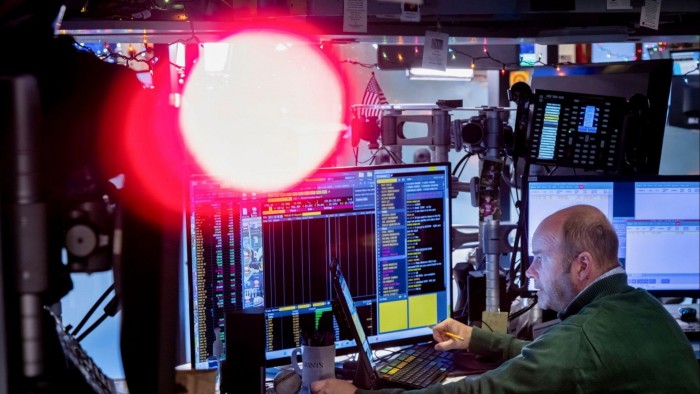Latest news on ETFs
Visit our ETF Hub to find out more and to explore our in-depth data and comparison tools
All roads led to Wall Street in November as the US equity market dominated a record month for the global exchange traded fund industry.
Net flows into ETFs globally hit $205bn in last month, according to BlackRock, outstripping the previous record of $199bn set in July.
Yet US equity ETFs accounted for a record $149bn of this — well ahead of the previous peak of $98.5bn in December 2023 — as virtually every other corner of the investment universe was ground into the dust by the onward march of Wall Street.
Fixed income ETFs pulled in an anaemic $35.1bn, comfortably below October’s $49.9bn, while commodity ETFs suffered net outflows of $3.6bn as investors pulled money out for the first time since April.
Non-US equity markets were similarly out of favour, with $5.1bn stripped from European equity ETFs, $2.9bn from Japanese stock funds and $3.8bn from their emerging market peers — the first time all three markets have recorded concurrent monthly outflows since May 2019, according to BlackRock.
The surge into the US stock market was driven by Donald Trump’s clear victory in the US presidential election, which built on already strong market momentum.

November was a “historic month”, said Karim Chedid, head of investment strategy for BlackRock’s iShares in the Emea region, with “the big theme rerisking from investors in a month where we have had clarity around the outcome of the US election”.
Chedid said this built on strong sentiment emanating from the recently concluded earnings season, which delivered 7 per cent year-on-year earnings, comfortably ahead of subdued expectations of 3 per cent, alongside a widening gap in economic data between the US and a weaker Europe.
Matthew Bartolini, head of SPDR Americas research at State Street Global Advisors, said this transatlantic gulf was wider still in equity markets, with the S&P 500’s post-election jump of 6 per cent in November taking its year-to-date gains to 26 per cent, even as a post-election wobble in European equities amid fears of higher tariffs trimmed year-to-date returns to 5 per cent.
This 21 percentage point return differential is the highest for 15 years, Bartolini said. This “illustrates how there is more to the US’s reign than the recent post-election rally narratives,” he added.
“For starters, the US has had stronger fundamental momentum in 2024. Forward-looking sentiment is strong too. The US is projected to have stronger earnings growth in each of the next four quarters — 6 percentage points, on average — than the rest of the world.”
Amid this backdrop, some European investors appear to be giving up on their domestic bourses: net purchases of Europe-listed US equity ETFs hit a record $23.2bn in November, BlackRock said.
“Investors overseas jumped at the opportunity to increase exposure to the US stock market,” said Syl Flood, senior product manager at Morningstar, with the Ireland-domiciled iShares Core S&P 500 ETF USD (CSSPX) pulling in $4bn, $1bn more than its previous monthly record, set in January.
Bartolini, whose analysis only covers US-listed ETFs, said that the rolling three-month flow differential between US and non-US equity ETFs hit an “eye-popping” $188bn, another record.
While ETFs tracking the blue-chip S&P 500 dominated flows, as usual, Chedid noted that more cyclical areas, such as small and mid-cap stocks and financials, also saw strong buying, mirroring the pattern in the wake of Trump’s previous election victory in November 2016.
His undisputed re-election “has removed the uncertainty premium for markets,” Chedid said, while also potentially ushering in lighter regulation, particularly for financial stocks.
“Investors placed unusually large sums with financials-focused ETFs,” said Flood, with monthly flows topping $9.4bn, yet another record.
“The Financial Select Sector SPDR ETF (XLF), the largest financials sector equity ETF at $51bn, saw record flows of $4.1bn” even though more than $1bn of this was withdrawn in the first three days of December, he added.
“Investors made an even larger proportional bet on SPDR S&P Regional Banking ETF (KRE); it grew by a third due to November’s flows of $1.4bn”.
Flood also noted that Ireland, Europe biggest ETF domicile, saw record inflows of $31.5bn (taking assets to $1.6tn), with the entirety of this money being pumped into equities.
And although US-domiciled fixed income ETFs did see inflows, Bartolini calculated that equity minus bond trailing three-month flows hit yet another record.
Virtually the only other asset that did see a good month was cryptocurrency. Morningstar’s list of the top 10 ETFs by flows in November was dominated by US equity vehicles with the sole exception being the iShares Bitcoin Trust (IBIT), nestled in fifth with $5.8bn of net new money as Trump election ushered in a fresh wave of enthusiasm for digital assets.
The big question now is whether Wall Street can maintain its extreme ascendancy, or whether flows will become a little more balanced.
“That’s a big question that clients ask us,” said Chedid. “In our view there are fundamentals that drive that preference for US equities. We see some selective opportunities coming through in other parts of the world, but we do need to emphasise the word ‘selective’,” he added, noting that “this year has been decent for UK equities”.
And while continental Europe “has been somewhat weaker in terms of flows”, amid “a structural decline in manufacturing activity” a service sector recovery that has “fizzled out” and an unhelpful geopolitical backdrop, Chedid did note that actively managed European equity ETFs had seen net buying, something he attributed to investors seeking out such selective opportunities.
https://www.ft.com/content/d312e5e6-e988-4125-9607-ca34e1bbcde6


